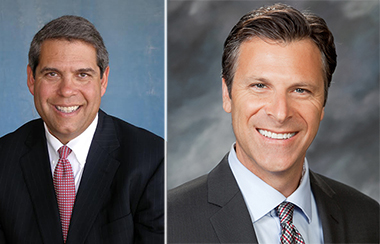Trending
Avison Young’s Chris Cooper and Peter Sherman on broker defections, the M&A market and pricing sticker shock

The brokerage industry experienced some of the biggest shake-ups in recent memory last year, with a series of mergers and acquisitions altering the landscape and leaving brokers reeling. Among the largest deals were CBRE’s $1.47 billion acquisition of facilities-management business Global Workplace Solutions and the $2 billion merger of Cushman & Wakefield and DTZ.
Against that backdrop, Canadian brokerage Avison Young has been trying to establish its U.S. business. It opened its first Los Angeles area office in 2011 and has been steadily nabbing top talent from rival firms, such as CBRE multifamily broker Peter Sherman and Jay Maddox of Kibel Green Inc., a turnaround advisory firm.
We sat down with Chris Cooper, a principal and managing director in the Downtown L.A. office, and Sherman to talk about the M&A frenzy, the recent flurry of broker moves and the challenges of breaking into the Southern California market.
What do you think is driving the trend of high-profile brokers switching firms?
Cooper: It’s a little crazy. People used to say that when the market is real good, no one makes a move because they don’t want to rock the apple cart. Well, the market is pretty darn good and we’re still seeing quite a bit of movement going on in the market. We are going through a fairly robust and unusually active M&A environment right now. With all the M&A going on, it creates consternation in the system. It creates uncertainty for a lot of the brokers.
On that note, what do you make of the recent trend of consolidation in the brokerage business?
Cooper: You’ve got some Wall Street players that are seriously investing in and acquiring commercial real estate services firms, with the likes of what you’re seeing with Newmark, Cushman & Wakefield and others. Time will tell whether they’re wise moves or not. There are certainly jitters in the equity markets and that could have an adverse impact on some of the recently completed as well as future mergers and acquisitions. Fortunately, we don’t fall victim to those kinds of things.
We’ve been fortunate enough to pick up a good handful of folks that constitute top talent in the industry because they have elected not to be part of that new type of organization or that new environment. They’re looking for something where they have a seat at the table, where they have equity and ownership in the organization, a say in who joins and who doesn’t.
What’s AY’s secret sauce in terms of recruiting talent?
Cooper: The way you get traction is culture. We’re the last bastion of sanity in that we’re a privately held, principal owned and principal run business. Our people don’t wake up in the morning and find out that the company has been sold or merged. Those kinds of things cannot happen unless all of the principals in this organization raise their hands and say, ‘This is something we want to do.’ The challenge we’ve had here in Southern California is not diluting or otherwise poisoning the culture we’ve built in our organization.
Sherman: For me, it was exciting to be able to take much more of an entrepreneurial position with a company as compared to CBRE, which was already so mature in the industry.
How are things coming along with your L.A. expansion?
Cooper: If you think about it, we opened our first door in Southern California in August of 2011 with a small group of brokers in West L.A. Four years and change later, we’re over 110 professionals in six offices delivering all service lines throughout the region. Our footprint now goes everywhere from the San Fernando Valley through West L.A., Downtown L.A., Irvine and even down to San Diego.
Sherman: There’s a lot of symbiosis with me coming on to deal with multi-family with some of the already built up strength they have in retail and in office.
What are some of the most exciting trends happening in the market right now?
Sherman: One of the most exciting things about the L.A. market now is this devotion to greater density in strategic neighborhoods. You’re seeing new neighborhood centers popping up along metro line hubs. You’re seeing L.A. turn from this sort of broad sprawl to an amalgamation of small city centers. Even Playa Visa, which doesn’t benefit from the metro line, is really benefitting from the moves of major Silicon Valley companies to have major campuses. It’s becoming a real neighborhood with a town center unto itself.
What about sources of capital? Are you still seeing a lot of foreign investors active in the market?
Sherman: You’ve seen a lot of capital from Asia coming into Downtown L.A. specifically on the development side as opposed to the acquisition of existing core assets. There’s talk and there’s interest in that changing but that money has really gone into entitled land so far.
Cooper: Some of the foreign money is beginning to get a little bit of sticker shock, especially in the core markets like Downtown L.A., West L.A., Silicon Beach and the Bay Area. We’re advising a lot of our clients who are looking to get some level of returns to begin to look in secondary or tertiary markets, be they El Segundo, Anaheim or other off-core markets. It’s just become so expensive and we’re seeing such cap rate compression that it’s brutal.




